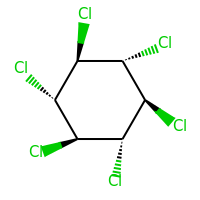
beta-Hexachlorocyclohexane
| Chemical | Gene Symbol | Gene Name | Interaction source |
|---|---|---|---|
| beta-Hexachlorocyclohexane | VDR | vitamin D (1,25- dihydroxyvitamin D3) receptor | ToxCast |
| beta-Hexachlorocyclohexane | ERBB2 | erb-b2 receptor tyrosine kinase 2 | CTD |
| beta-Hexachlorocyclohexane | CYP24A1 | cytochrome P450 family 24 subfamily A member 1 | ToxCast |
| beta-Hexachlorocyclohexane | FASN | fatty acid synthase | CTD |
| beta-Hexachlorocyclohexane | AR | androgen receptor | ToxCast |
| beta-Hexachlorocyclohexane | SRC | SRC proto-oncogene, non-receptor tyrosine kinase | CTD |
| beta-Hexachlorocyclohexane | RXRA | retinoid X receptor alpha | ToxCast |
| beta-Hexachlorocyclohexane | ESR1 | estrogen receptor 1 | CTD|ToxCast |
| beta-Hexachlorocyclohexane | RARG | retinoic acid receptor gamma | ToxCast |
| beta-Hexachlorocyclohexane | NR1I2 | nuclear receptor subfamily 1 group I member 2 | CTD|ToxCast |
| beta-Hexachlorocyclohexane | ABCG8 | ATP binding cassette subfamily G member 8 | CTD |
| beta-Hexachlorocyclohexane | TSHB | thyroid stimulating hormone beta | CTD |
| beta-Hexachlorocyclohexane | MMP9 | matrix metallopeptidase 9 | CTD |
| beta-Hexachlorocyclohexane | MAPK1 | mitogen-activated protein kinase 1 | CTD |
| beta-Hexachlorocyclohexane | MAPK3 | mitogen-activated protein kinase 3 | CTD |
| beta-Hexachlorocyclohexane | ESR2 | estrogen receptor 2 | CTD|ToxCast |
| beta-Hexachlorocyclohexane | RARA | retinoic acid receptor alpha | ToxCast |
| beta-Hexachlorocyclohexane | HDAC6 | histone deacetylase 6 | ToxCast |
| beta-Hexachlorocyclohexane | SERPINA7 | serpin family A member 7 | CTD |
| beta-Hexachlorocyclohexane | ACADS | acyl-CoA dehydrogenase, C-2 to C-3 short chain | CTD |
| beta-Hexachlorocyclohexane | RARB | retinoic acid receptor beta | ToxCast |
| beta-Hexachlorocyclohexane | CYP4F12 | cytochrome P450 family 4 subfamily F member 12 | ToxCast |
| beta-Hexachlorocyclohexane | SREBF1 | sterol regulatory element binding transcription factor 1 | CTD |
| beta-Hexachlorocyclohexane | PPARD | peroxisome proliferator activated receptor delta | ToxCast |
| beta-Hexachlorocyclohexane | HIF1A | hypoxia inducible factor 1 alpha subunit | ToxCast |
| beta-Hexachlorocyclohexane | ACADM | acyl-CoA dehydrogenase, C-4 to C-12 straight chain | CTD |
DISCLAIMER
ExHuMId is a knowledgebase compiled through manual curation of published scientific literature wherein environmental contaminants were detected in human milk samples across India. We are not responsible for any errors in published scientific articles from where the human milk exposome specific to India was compiled. We are also not responsible for any omission of published scientific articles containing information on human milk exposome specific to India. Importantly, our primary goal to build this resource was to enable future research on human exposome studies specific to India. Hence, the views expressed in this work are solely based on our scientific understanding of the topic, and they do not necessarily reflect the views or policies of our employers or funders.